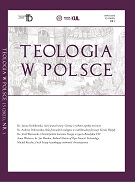Inkarnacja Syna jest bowiem istotnie i pierwszorzędnie wewnątrztrynitarnym aktem duchowym, przyjęciem ciała przez Syna, przyjęciem, które jest zgodą Syna słuchającego Ojca (posłusznego Ojcu). To posłuszeństwo zostaje wcielone, odpowiedź Syna „staje się ciałem”, teologia Słowa staje się teologią Wcielenia.
…but a bod y you prepared for me … (Heb 10:5).
The Theolog y of the Incar natio n Accordi ng to J. Ratzi nger /
Benedict XVI
Summary
J. Ratzinger / Benedict XVI proposes a theology of the Incarnation built on the Christology of meaning. In essence, he derives it from two biblical texts: the Prologue of the Gospel of John and the Epistle to the Hebrews. The present Pope closely links the event of the Incarnation with the creation and the Trinity dogma. The Word that became flesh had existed since the beginning (the eternal Logos); the Incarnation is a consequence of the intra-Trinitarian relationship. Jesus of Nazareth is the Son of God – this is the central Christological truth, whose gospel testimony is to be found in the words of Jesus Himself and in His prayer. Therefore, the event of the Incarnation is at the same time an event of revelation and salvation: Jesus is the real “place” of God’s presence and the real “instrument of propitiation” – hilasterion. The historical singularity and the material limitation of Jesus of Nazareth’s life as well as the consequent sacramental spirituality of the Church are, on the one hand, a manifestation of God’s humility and, on the other, a guarantee of divine presence and the definiteness of salvation. The death and resurrection of the Son of God restores the original (created) meaning to the world and gives it the ultimate meaning, which man regains by participating in the Son’s gesture – His relation to the Father.
Ostatnia aktualizacja: 27.02.2012, godz. 10:38 - Janusz Lekan































